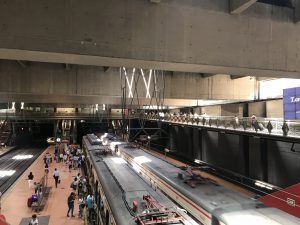
UITP, UNIFE and UIC have come together to highlight the public transport essential role in our recovery as it can fight against climate change and tackle the huge challenges, as the Covid-19 crisis. The three associations are calling the support of the European Union and its Member States to place public transport at the centre of the world of tomorrow.
“During the coronavirus pandemic, we have seen how the sector has stepped forward and stood strong during this crisis. As we advocate for its futureat every turn, we must continue to recognise the role it plays in delivering action on climate. Public transport and the environment are inextricably linked and with a strong local network, emissions are lowered and our cities become healthier and more sustainable,” Mohamed Mezghani, UITP Secretary General, said.
The associations commend the European Commission’s new Next Generation EU and the 2027 MFF proposals as well as the recent assessment of the Green Deal as the EU’s recovery strategy that requires a boost for rail travel and clean mobility in the cities and regions to achieve climate neutrality.
2021 has been announced as the European Year of Rail, “but it must also celebrate sustainable mobility and public transport. We are committed to building a new mobility paradigm for Europe’s sustainable future,” the joint statement says.
“UNIFE believes that the EC’s recent MFF and Next Generation EU proposals are powerful recovery instruments that can help complete EU Green Deal objectives but they must be mobilised for the decarbonisation of European transport. This is only possible through a greater multimodal mobility shift with rail at its backbone,” said Philippe Citroen, UNIFE Director General.
For the transport sector, pandemics and the climate change are two phenomena are closely linked.
The sector has an incredible contribution to tackle the challenge of climate change if sustainable transport is promoted. The available transport modes are responsible for 22% of emissions that endanger natural ecosystems, but the railways and public transport essential role is to reduce the carbon footprint.
In Europe, railways accounts for 7.6% of passenger and 17.6% of freight transport, but only creates 0.5% of its GHG emissions. With regard to the average energy consumption, urban rail with its 0.12 kWh per passenger-km is 7 times more energy efficient than private cars in cities. Railways’ carbon footprint is significantly smaller than those of the other transport modes. Much of this efficiency stems from rail’s ability to convey mass amounts of passengers and goods with vehicles that are largely electric.
The associations are committed to advocate the development of the public transport and supply industry, but they are “are conscious that this, alone, will not be enough”.
“The customer experience must be revolutionised through the creation of seamless multimodal mobility network that places rail at its backbone and utilizes flow management to anticipate consumer patterns. It is possible to reform cumbersome elements of public transport which act as a barrier to usage. If we act now, public rail transport can be more widely associated with freedom, flexibility and comfort.”
The associations highlight that a sustainable mobility is “not synonymous with individual vehicles” and to do so, the public must understand rail’s value to urban life. As is providing higher capacity, it can make our cities less congested and less polluted, while maintaining a multimodal system that adequately and equally serves metropolises, conurbations and their surrounding regions.
Public acceptance of autonomous rail vehicle integration into public transport infrastructure is key for improved mobility and diminished environmental impact
Railways and public transport are to be developed if investments are directed to the new infrastructure projects and rolling stock, while boosting the research and innovation that has the ability to create a strong and sustainable transport system. The transport networks need more infrastructure to provide increased capacity which will meet the future mobility demands. Research and innovation are the answer to approach all these challenges and shape the way future networks to meet transport needs.
The developments will revolve around autonomous vehicles, the Internet of Things and artificial intelligence. This will be made possible by focusing on a new telecommunications infrastructure that makes the best use of 5G technology, which is being worked on by the entire rail industry.
“Given the clear successes of the Shift2Rail Joint Undertaking, it must be extended as Shift2Rail under Horizon Europe to provide the sector an ambitious innovation programme that aims to transform European transport.”
Share on:



